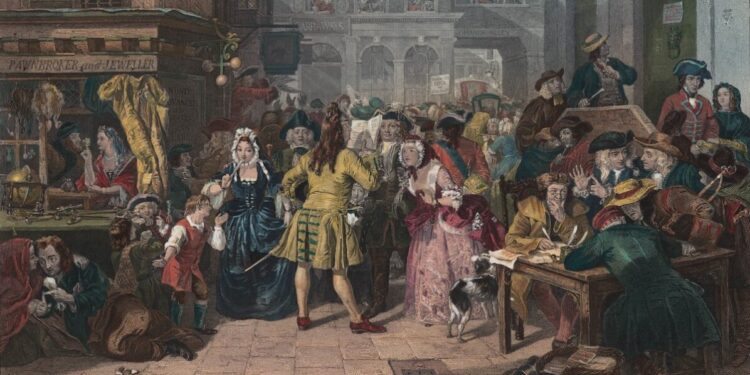“Extraordinary Popular Delusions and the Madness of Crowds” is a book written by Charles Mackay and first published in 1841. The book examines several “popular delusions” or widespread beliefs that have been held throughout history, including the Tulipomania, the Mississippi Scheme, the South Sea Bubble and the Crusades. Mackay finds that these delusions were fueled by mass hysteria and a lack of critical thinking. He seeks to educate readers about the dangers of blindly following the crowd.
Charles Mackay was a Scottish poet and journalist who was born in 1814. He was a prolific writer and published several books on a variety of subjects including economics, psychology and history. “Extraordinary Popular Delusions and the Madness of Crowds” is perhaps his most well-known work and has been widely praised for its insights into human behavior and the perils of mass hysteria.
The book is divided into five sections, each of which focuses on a different type of popular delusion.
Section 1: Historical Delusions
The first section of Charles Mackay’s book “Extraordinary Popular Delusions and the Madness of Crowds” is devoted to historical delusions, which are widespread beliefs that have been held throughout history and have often had disastrous consequences. In this section, Mackay introduces several specific historical delusions including the Tulipomania, the Mississippi Scheme and the South Sea Bubble, which were all financial schemes that defrauded thousands of people.
The Tulipomania was a period of time in the 17th century when the price of tulip bulbs in the Netherlands reached absurdly high levels and then suddenly collapsed, causing financial ruin for many people. According to Mackay, the Tulipomania began in the 1630s, when tulip bulbs were first introduced to the Netherlands from Turkey. The bulbs were considered a luxury item, and they quickly became very popular among the wealthy. As demand for tulips increased, the prices of the bulbs began to rise, and people began to speculate on their value. Some people even sold their homes and possessions in order to buy tulip bulbs, believing that they could sell them for a profit at a later date.
However, the market for tulip bulbs eventually became oversaturated, and the prices began to plummet. Many people who had invested heavily in the bulbs were left with large losses, and the Tulipomania came to an end. Mackay sees the Tulipomania as an example of a popular delusion, as it was fueled by mass hysteria and a lack of critical thinking. He suggests that people became caught up in the hype and believed that the prices of tulip bulbs would continue to rise indefinitely, despite the lack of evidence to support this belief. He also points out that the Tulipomania was fueled by greed, as people were drawn in by the promise of easy money.
The Mississippi Scheme, also known as the Mississippi Bubble, was a financial scam that took place in France in the early 18th century. It was led by a Scottish financier named John Law, who convinced the French government to grant him a monopoly on trade in the Mississippi Valley in exchange for his help in resolving the country’s financial crisis. Law then issued shares of stock in a company called the Mississippi Company, which he claimed would generate huge profits from the trade in the valley. However, the company was actually a front for a Ponzi scheme and Law had no intention of making any actual profits. The scheme finally collapsed, causing widespread financial ruin and leading to a major economic crisis in France.
The South Sea Bubble was a similar financial scam that took place in England in the early 18th century. It involved the South Sea Company, which was granted a monopoly on trade with South America in exchange for taking on a large portion of the country’s national debt. The company issued shares of stock, which were widely purchased by investors who believed they would make huge profits from the trade. However, the company was not actually profitable and finally also this bubble burst, leading – once more – to widespread financial ruin.
Section 2: Religious Delusions
The second section of Charles Mackay’s book focuses on religious delusions. Mackay examines several specific religious delusions, including the Crusades and the witch mania.
The Crusades were a series of military campaigns which happened in the Middle East in the 11th, 12th, and 13th centuries. They were launched by European Christians with the goal of recapturing the Holy Land from Muslim control. Mackay states that the Crusades were an example of a religious delusion, as they were fueled by religious fervor and a belief in the divine right of the Christian crusaders. He suggests that many people became caught up in the hype and believed that they were on a holy mission, despite the lack of evidence to support this belief. He concludes that the Crusades were fueled by greed, as many people believed that they would be rewarded with wealth and power if they participated in the campaigns.
The witch mania happened in the 16th and 17th centuries when there was widespread belief in the existence of witches and a fear of witchcraft. This belief led to the persecution of thousands of people, especially women, who were accused of being witches and were often subjected to torture and execution. Mackay argues that the witch mania was an example of a religious delusion, as it was fueled by superstition and a belief in the power of the devil. People at this time became caught up in the hype and believed in the existence of witches, despite any evidence.
Section 3: Modern Delusions
The third chapter of “Extraordinary Popular Delusions and the Madness of Crowds” is examining modern delusions. These are are widespread beliefs of people in more recent history including the magnetizers and the great political fools of the 19th century.
The magnetizers were individuals who claimed to have the power to heal through the use of magnets. They believed that they could transfer the “magnetic fluid” from their own bodies to the bodies of their patients and that this would cure various ailments. Mackay argues that the magnetizers were an example of a modern delusion, as their claims were not supported by any scientific evidence and instead based on superstition.
The great political fools of the 19th century were leaders who made disastrous decisions due to their ego and hubris. Mackay examines several specific examples of these political fools, including Napoleon Bonaparte and President James Buchanan. He argues that these leaders were caught up in their own delusions of grandeur and believed that they were infallible without any evidence to support this belief. He suggests that their hubris led them to make disastrous decisions that had significant consequences for their countries and the world.
Section 4: Moral Delusions
The fourth part of Charles Mackay’s book “Extraordinary Popular Delusions and the Madness of Crowds” has a closer look at moral delusions, which are widespread beliefs which lead to disastrous consequences. In this section, Mackay introduces several specific moral delusions, including the influence of politics on the stock exchange and the dangers of speculation.
One especially striking example of a moral delusion is the influence of politics on the stock exchange. Mackay argues that politics often have a significant impact on financial markets and that this can lead to widespread delusions about the value of certain assets. He suggests that people may become caught up in the hype and believe that certain assets are more valuable than they actually are, primarily due to political factors, and that this can lead to financial ruin.
In the same context, Mackay highlights the general dangers of speculation. He argues that speculation of any kind – which he defines as the act of investing in an asset in the hopes of selling it at a higher price in the future – is very risky and can lead to financial ruin if it is not approached with caution. He believes that people may become too greedy and get caught up in hypes which promise to make them easy money – again – despite the lack of evidence to support this belief.
Section 5: Miscellaneous Delusions
In the fifth and last section of his book, Charles Mackay examines several specific miscellaneous delusions, including the power of music and the great fire of London.
The power of Music is one example of a miscellaneous delusion. The author argues that music has often been believed to have the power to heal, to inspire, and even to control the behavior of others. Once more people may become caught up in the hype and believe in the power of music, rather because of superstition and a lack of understanding of the true nature of music than through any scientific evidence.
Also the great fire of London is an example which Mackay puts on his list of miscellaneous delusions. The great fire of London, which was a major conflagration that destroyed much of the city in 1666, was fueled by a number of delusions including the belief that it was caused by the Great Plague, which was sweeping through the city at the time, and the belief that it was a divine punishment for the sins of the people. He suggests that these delusions were fueled by fear and a lack of understanding of the true causes of the fire.
As illustrated in the summary, Mackay uses a wide range of historical examples throughout the book to illustrate his points and to show how these delusions have played out in the past. He also includes personal anecdotes and observations to add depth to his analysis. All in all, the book is well-written and engaging, and it provides valuable insights into the dangers of blindly following the crowd and the importance of critical thinking.
“Extraordinary Popular Delusions and the Madness of Crowds” was well-received by critics upon its release and has remained popular over the years. Many reviewers praised Mackay’s writing style and the depth of his analysis, and some have even called it a classic of its kind. The book has been widely cited in academic circles and has been translated into several languages. It remains an important work that continues to be relevant today, as it highlights the dangers of mass hysteria and the importance of thinking for oneself.










